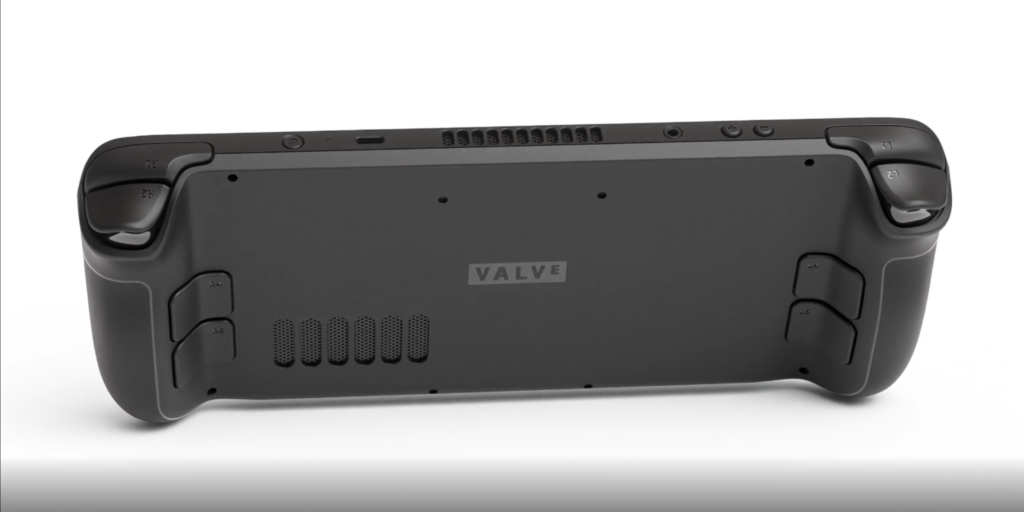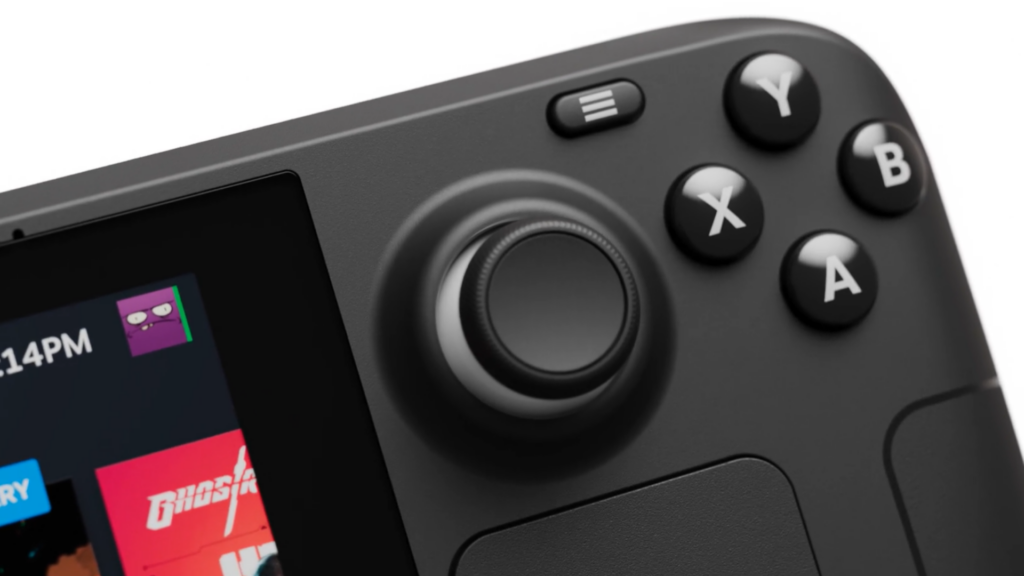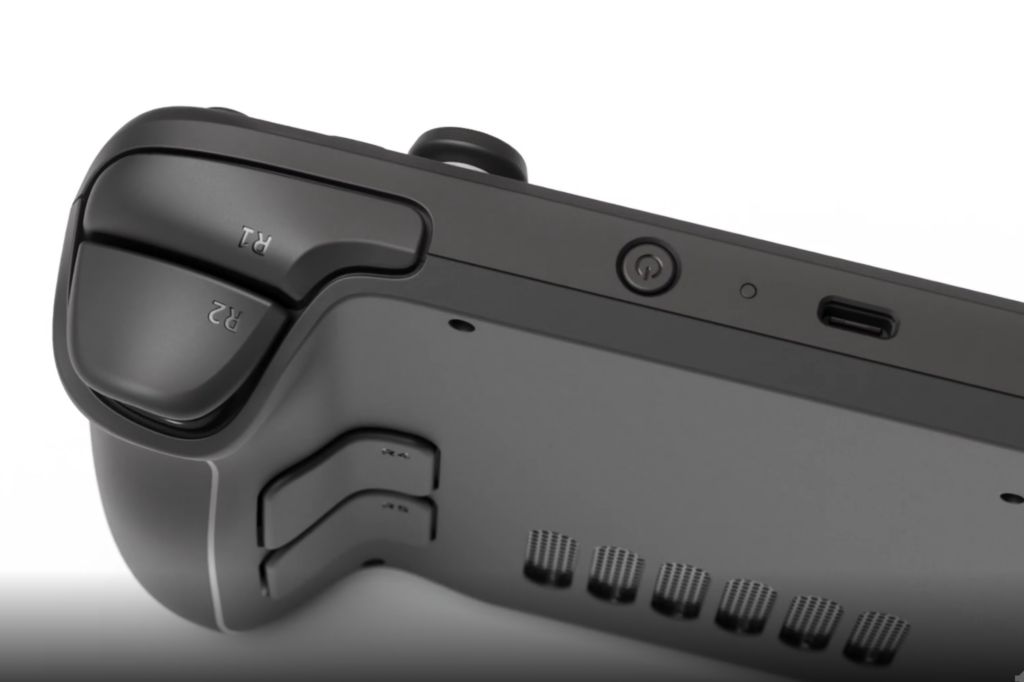The Valve Steam Deck is a newly confirmed portable gaming device, which is essentially a handheld gaming PC with a Nintendo Switch form factor.
Featuring an AMD Zen 2 CPU and an Nvidia RDNA 2 GPU, the Steam Deck sets itself apart from the Switch since it has more powerful specs and is capable of playing virtually any AAA game in the Steam library. So far, it’s been tipped as having a similar performance level as the PS4 and Xbox One.
The Steam Deck sports a 7-inch LCD touchscreen display with a 12800×800 resolution and a 60Hz refresh rate. It’s also capable of outputting to an external display via its USB-C port, although the dock will be sold seperately.
Valve has also confirmed that there will be three configuration options, all with the same CPU and GPU, but with varying storage capacities: 64GB, 256GB and 512GB. Storage will also be expandable via MicroSD cards.
Steam Deck will be running on SteamOS out of the box, which is a Linux-based operating system. However, Valve has confirmed you can treated this device like a normal PC, and install Windows if you prefer.
Keep on reading for a more detailed breakdown of the Steam Deck, and keep this page bookmarked for future updates.
Release date
The Steam Deck is confirmed to launch in December 2021 this year.
While you won’t be able to order the device until December, Valve is allowing people to make a reservation and enter a queue.
Reservations are opening on the Steam website at 6pm UK time (10am PDT) today. Head over to the site, and you can set a reminder so you don’t miss out during the mad rush.
Price
The Steam Deck has a starting price of £349 / $399, which gets you 64GB eMMC storage and a bundled carrying case.
The second configuration costs £459 / $529, featuring larger 256GB that also benefits from faster speeds thanks to the jump to an NVMe SSD.
And finally, there’s a top-of-the-line £569 / $649 model with a beefy 512GB NVMe SSD. You also get a premium anti-glare etched glass for the screen too, as well as an exclusive virtual keyboard theme.
Specs
We’ve listed the Steam Deck specs below:
| CPU | AMD Zen 2 (4-core, 8-thread @ 2.4GHZ – 3.5Ghz) |
| GPU | RDNA 2 (8 compute units @ 1GHz – 1.6GHz) |
| RAM | 16GB DDR5 |
| Storage | 64GB eMMC base / 256GB NVMe SSD / 512GB NVMe SSD (microSD expansion) |
| Display | 7-inch, 1280×800 (16:10), 60Hz LCD touchscreen |
| Battery | 40WHr: “2-8 hours of gameplay” depending on title |
| Video output (docked) | Up to 4K @ 120Hz / 8K @ 60Hz |
| Connectiivity | 2.4GHz / 5GHz Wi-Fi and Bluetooth 5.0 |
| Weight | 669 grams |
Performance
However, those specs are optimised for a 720p resolution, so don’t expect it to be as powerful as a modern desktop gaming PC. IGN has suggested that it offers roughly the same performance power as a PS4 or Xbox One, which is very impressive since it’s battery powered.

Thanks to the RDNA 2 GPU, the portable should also support high-end features such as ray tracing and DLSS.
Most importantly, it looks like the Steam Pal should handle the vast majority of games in the Steam library, albeit at a 720p resolution and dialled back graphics settings for the most demanding titles.

The Steam Deck is also capable of outputting to an external display via the USB-C port, with up to 4K @ 120Hz / 8K @ 60Hz results. However, don’t get excited by the mention of 4K or 8K, as this portable isn’t really powerful enough to handle such resolutions for the majority of games. Still, it opens up the potential for the Steam Deck working in tandem with an eGPU further down the line.
The Steam Deck also packs Bluetooth connectivity, which means you can use wireless headsets or even hook up your PlayStation / Xbox controller.
Design
The Steam Deck has a rather peculiar design. At first glance, it looks very similar to the Nintendo Switch. Look again, and you’ll notice some major differences.
Firstly, the Steam Deck is substantially bigger than the standard Switch, with a 7-inch screen and larger controllers. It’s also significantly heavier, with a 669g weight trouncing the comparatively dainty 297g Nintendo Switch.

The Steam Deck has a lot more buttons on it too. There are two analogue sticks in the top-hand corners, but they’re joined by two trackpads, which apparently help to simulate the input of a mouse.
The standard shoulder bumpers and triggers can be found up top, but there are also some grip buttons at the back which can be assigned with custom input. This is very similar to the Xbox Elite Controller 2.
The handheld devices sports both a USB-C port (for charging and display output) and a 3.5mm jack for wired headphones.
Screen
The Steam Deck features a 7-inch LCD touchscreen display. This is one area where the Switch OLED takes the victory, since the OLED panel will likely offer superior contrast and picture quality.
The Steam Deck is limited to an 800p resolution, which is slightly better than the Switch but still misses out on the Full HD target. That said, boosting the screen resolution would also take a hit on the battery life, so it’s not too important to have such a high pixel count on such a small, portable device.
The refresh rate is capped to 60Hz, which may be a disappointment for those wanting to play competitively, but again, makes sense in terms of battery efficiency.
The Trusted Take
The Steam Deck looks incredible, blowing the Switch OLED out of the water with beefier specs and a larger game library thanks to SteamOS support.
However, it’s an expensive device, especially considering the base model offers a pitiful onboard storage that will struggle to fit even one modern AAA game. It’s also considerably heavier than the Switch, putting its portability prowess in some doubt.
But the potential of this device is still remarkable, supporting the likes of ray tracing and having an incredibly high display output when docked, which could possibly compliment an eGPU. And if you install Windows on the device, it may even become a superb option for on-the-go Game Pass.
